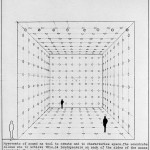Harmonic Synth
Lord Kelvin’s harmonic synthesizer is basically Henrici’s harmonic analyzer (see later) in reverse. Originally designed as a tide predictor in 1873, the system can combine numerous component waves—in some devices, up to 64 separate components—into a single curve. It is based on the earlier pin-and-slot device, which produces simple harmonic motion with the turn of a crank.
The version used by Dayton Miller was designed and built in the laboratory and instrument shop of the Physics Dept. of the Case School of Applied Sciences. It consisted of 32 rotating pin-and-slot devices (see diagram below), each of which produced simple harmonic motion with a specified amplitude and phase; these 32 elements controlled the motion of a single cable that traced out the combined wave with a stylus and sliding drafting table. It was used by Dayton Miller to check the results produced by the harmonic analyzer against the original phonodeik curve. This device is no longer in the CWRU Physics Dept. collection.





Harmonic Analyser
In 1894, Olaus Henrici (1840-1918) of London devised a harmonic analyzer for determining the fundamental and harmonic components of complex sound waves. It consists of multiple pulleys and glass spheres, called rolling-sphere integrators, connected to measuring dials. The image of a curve (for example, a phonodeik tracing of a sound wave) is placed under the device. The user moves a mechanical stylus along the curve’s path, tracing out the wave form.
The resulting readings on the dials give the phase and amplitudes of up to ten Fourier harmonic components. According to Dayton Miller, the harmonic analyzer was “developed and mechanically perfected by Mr. G. Coradi, of Zurich; and, as constructed by him, they are not only of beautiful workmanship, but they are also calculating machines of high precision” (J. Franklin Inst. Sept 1916. p 288).
Miller used the device in his work in acoustics and the theory of musical instruments beginning in 1908. He analyzed thousands of images of sound waves recorded with his phonodeik. Once the components of a curve had been determined, he used a harmonic synthesizer to check these results, by recombining all the individual components into a new curve, which was then compared to the original phonodeik trace.
A more detailed description of how the analyzer works may be found in the Miller chapter of “Physics at a Research University: Case Western Reserve 1830-1990” by William Fickinger


From phys.cwru.edu, where you can find videos of the harmonic analyser in action.





Leave a Reply